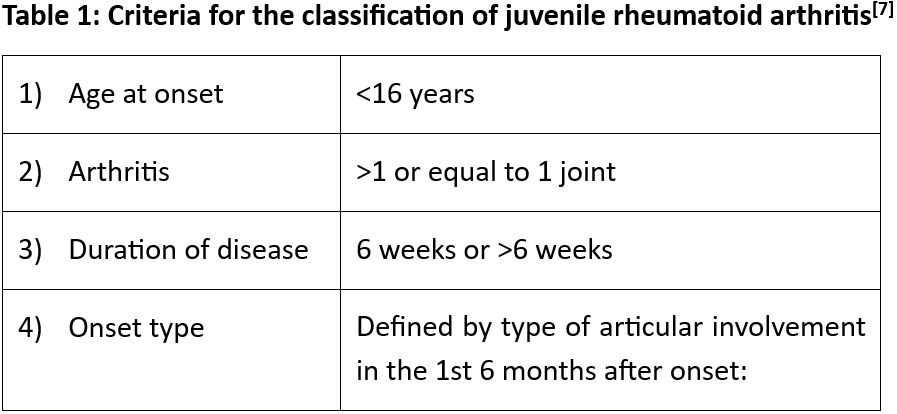An Ayurvedic Review on Juvenile Idiopathic Arthritis along with its Management
DOI:
https://doi.org/10.21760/jaims.10.6.33Keywords:
Juvenile idiopathic arthritis, Amavata, Vaitaran Basti, VirechanaAbstract
Juvenile idiopathic arthritis (JIA) is the most common rheumatic disease in children and one of the more common chronic illnesses of childhood. It refers to a group of conditions characterized by chronic inflammatory changes of the joints. During the course of a disease the number of involvement of joints, type of joints involved will decide the type of JIA according to ILAR classification. The symptoms present in JIA are more comparable with features of Amavata Vyadhi mentioned in Ayurvedic classics. Amavata is a chronic disease of joints pain and body ache accompanied by a swelling of some or all of the synovial joints which involves Ama and Vata. It is a disease of Madhyam Marga Roga as it affects Sandhi and Hridaya Marma. The main line of treatment for Juvenile idiopathic arthritis (JIA) to bring Agni (digestive power) in normal state to digest Ama. Shodhana and Shamana therapy of Ayurveda are useful to treat this disease. Shodhana therapy with Snehan with medicated oil, Nadi Swedan, Valuka Pottali Swedan and Mridu Virechan shows great improvement in the symptoms. It will also decrease the progression of disease. Rasayana is indicated in Samhitas that helps in preventing deformities and support physical and mental strength of a child.
Downloads
References
Paul VK, Bagga A. Ghai Essential Pediatrics. 8th ed. New Delhi: CBS Publishers and Distributors; 2013. p. 625.
Lakshamanswami A. Clinical Pediatrics. 5th ed. New Delhi: Wolters Kluwer; 2022. p. 679.
Kliegman RM, St Geme JW, Blum NJ, Shah SS, Tasker RC, Wilson KM. Nelson Textbook of Pediatrics. 21st ed. Philadelphia: Elsevier; 2020. p. 180–1258.
Madhavkara. Madhava Nidana: Amavata Nidana. Hindi commentary by Sastri B. Varanasi: Chaukhambha Sanskrit Sansthan; 2012. p. 6–10.
Kliegman RM, St Geme JW, Blum NJ, Shah SS, Tasker RC, Wilson KM. Nelson Textbook of Pediatrics. 21st ed. Philadelphia: Elsevier; 2020. p. 180–1258.
Agrawal M. Textbook of Pediatrics. 2nd ed. New Delhi: CBS Publishers and Distributors; 2017. p. 719.
Kliegman RM, St Geme JW, Blum NJ, Shah SS, Tasker RC, Wilson KM. Nelson Textbook of Pediatrics. 21st ed. Philadelphia: Elsevier; 2020. p. 1258–1259.
Bader-Meunier B, Wouters C, Job-Deslandre C, Cimaz R, Hofer M, Pillet P. Guidelines for diagnosis and treatment of oligoarticular and polyarticular juvenile idiopathic arthritis. Arch Pediatr. 2010;17(7):1085–9.
Lakshamanswami A. Clinical Pediatrics. 5th ed. New Delhi: Wolters Kluwer; 2022. p. 680.
Kliegman RM, St Geme JW, Blum NJ, Shah SS, Tasker RC, Wilson KM. Nelson Textbook of Pediatrics. 21st ed. Philadelphia: Elsevier; 2020. p. 1264–1265.
Paul VK, Bagga A. Ghai Essential Pediatrics. 8th ed. New Delhi: CBS Publishers and Distributors; 2013. p. 627.
Madhvakara S. Madhavanidanam. In: Upadhyaya Y, editor. Varanasi: Chaukhambha Sanskrit Sansthan; 1985. p. 25–1.
Madhavkara. Madhava Nidana Part-1. Sanskrit commentary Madhukosh by Tripathi B. Varanasi: Chaukhambha Surbharti Prakashan; 2010. p. 571.
Upadhyay Y. Madhavnidana Madhukoshtika. Amavataanidana Adhyay. Varanasi: Chaukhambha Sanskrit Sansthan; p. 1–10.
Singh B, Agrawal S. A literary study on Amavata Vyadhi – A most prevalent disease in India. JETIR. 2021;8(8).
Joshi YG. Kayachikitsa. Pune: PSV Publication; 2019. p. 226–227.
Upadhyay Y. Madhavnidana Madhukoshtika. Amavataanidana Adhyay. Varanasi: Chaukhambha Sanskrit Sansthan; p. 1–10.
Monier-Williams M. Sanskrit-English Dictionary. Oxford: Oxford University Press; 1895. p. 1.
Vagbhata. Ashtanga Hridayam. Edited by Paradkar V. Varanasi: Krishnadas Academy; 2000. p. 1.
Pooja BA, Kumar S, Bhatted, Bhojani MK. Role of Valuka Swedana and Vaitarana Basti in the management of Amavataa (Rheumatoid arthritis). Int J Res Ayurveda Pharm. 2013;4(5):712–4.
Agnivesha. Charaka Samhita. Chikitsasthana. Commentary by Chakrapanidatta. Varanasi: Chaukhambha Sanskrit Sansthan; 2004. p. 32.
Niraj SK, Varsha S. A case study on Ayurvedic management of spastic cerebral palsy due to birth asphyxia. J Nat Remedies. 2019;19(3).
Agnivesha, Charaka. Siddhisthana, Kalpanasiddhi Adhyay. In: Shastri R, Upadhyaya Y, Pandeya G, editors. Vidyotini Hindi Commentary. Varanasi: Chaukhambha Bharti Academy; 2009. p. 1–38.
Agnivesha, Charaka, Drdhbala. Siddhisthana, Kalpanasiddhi Adhyaya. In: Shastri R, Upadhyaya Y, Pandeya G, editors. Vidyotini Hindi Commentary. Varanasi: Chaukhambha Bharti Academy; 2009. p. 1–39.
Sushruta A. Sutrasthana, Dosha Dhatu Mala Kshaya Vriddhi Adhyaya. In: Sharma AR, editor. Sushruta Samhita Vimarshini Vyakhya. Varanasi: Chaukhambha Surbharti Bharti Academy; 2010. p. 15–4.
Wetal VR, Huperikar R. Study of effect of Vaitarana Basti in Amavataa: A clinical trial. Int J Ayu Pharm Chem. 2016;4(2):38–45.
Wanole MR, Clothe DS. Vaitarana Basti in Amavataa – A pilot study. EJPMR. 2016;3(11):379–82.
Pandey S, Joshi NP. Clinical efficacy of Shiva Guggulu and Simhanada Guggulu in Amavataa (Rheumatoid Arthritis). AYU. 2012;33(2):247–54.
Chhatre S, Nesari T, Sathya S. Phytopharmacological overview of Tribulus terrestris. Pharmacogn Rev. 2014;8(15):45–51. doi:10.4103/0973-7847.12553.
Sudha K, Mathanghi SK. Traditional underutilized green leafy vegetables and its curative properties. Int J Pharm. 2012;2:786–93.















